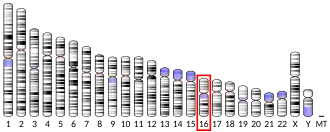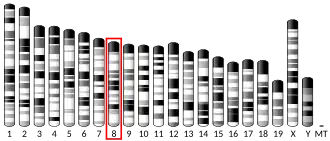Potassium-chloride transporter, member 4 is a chloride potassium symporter protein. It is encoded by the gene SLC12A4.[5]
See also
References
Further reading
- Larsen F, Solheim J, Kristensen T, et al. (1994). "A tight cluster of five unrelated human genes on chromosome 16q22.1". Hum. Mol. Genet. 2 (10): 1589–95. doi:10.1093/hmg/2.10.1589. PMID 8268911.
- Gillen CM, Brill S, Payne JA, Forbush B (1996). "Molecular cloning and functional expression of the K-Cl cotransporter from rabbit, rat, and human. A new member of the cation-chloride cotransporter family". J. Biol. Chem. 271 (27): 16237–44. doi:10.1074/jbc.271.27.16237. PMID 8663127.
- Pellegrino CM, Rybicki AC, Musto S, et al. (1998). "Molecular identification and expression of erythroid K:Cl cotransporter in human and mouse erythroleukemic cells". Blood Cells Mol. Dis. 24 (1): 31–40. doi:10.1006/bcmd.1998.0168. PMID 9516379.
- Su W, Shmukler BE, Chernova MN, et al. (1999). "Mouse K-Cl cotransporter KCC1: cloning, mapping, pathological expression, and functional regulation". Am. J. Physiol. 277 (5 Pt 1): C899–912. doi:10.1152/ajpcell.1999.277.5.C899. PMID 10564083.
- Casula S, Shmukler BE, Wilhelm S, et al. (2001). "A dominant negative mutant of the KCC1 K-Cl cotransporter: both N- and C-terminal cytoplasmic domains are required for K-Cl cotransport activity". J. Biol. Chem. 276 (45): 41870–8. doi:10.1074/jbc.M107155200. PMID 11551954.
- Strausberg RL, Feingold EA, Grouse LH, et al. (2003). "Generation and initial analysis of more than 15,000 full-length human and mouse cDNA sequences". Proc. Natl. Acad. Sci. U.S.A. 99 (26): 16899–903. Bibcode:2002PNAS...9916899M. doi:10.1073/pnas.242603899. PMC 139241. PMID 12477932.
- Bräuer M, Frei E, Claes L, et al. (2003). "Influence of K-Cl cotransporter activity on activation of volume-sensitive Cl− channels in human osteoblasts". Am. J. Physiol., Cell Physiol. 285 (1): C22–30. doi:10.1152/ajpcell.00289.2002. PMID 12637262.
- Shen MR, Chou CY, Hsu KF, et al. (2003). "KCl cotransport is an important modulator of human cervical cancer growth and invasion". J. Biol. Chem. 278 (41): 39941–50. doi:10.1074/jbc.M308232200. PMID 12902337.
- Ota T, Suzuki Y, Nishikawa T, et al. (2004). "Complete sequencing and characterization of 21,243 full-length human cDNAs". Nat. Genet. 36 (1): 40–5. doi:10.1038/ng1285. PMID 14702039.
- Zhou GP, Wong C, Su R, et al. (2004). "Human potassium chloride cotransporter 1 (SLC12A4) promoter is regulated by AP-2 and contains a functional downstream promoter element". Blood. 103 (11): 4302–9. doi:10.1182/blood-2003-01-0107. PMID 14976052.
- Khan AI, Drew C, Ball SE, et al. (2005). "Oxygen dependence of K+–Cl− cotransport in human red cell ghosts and sickle cells". Bioelectrochemistry. 62 (2): 141–6. doi:10.1016/j.bioelechem.2003.07.005. PMID 15039017.
- Colland F, Jacq X, Trouplin V, et al. (2004). "Functional Proteomics Mapping of a Human Signaling Pathway". Genome Res. 14 (7): 1324–32. doi:10.1101/gr.2334104. PMC 442148. PMID 15231748.
- Shen MR, Lin AC, Hsu YM, et al. (2004). "Insulin-like growth factor 1 stimulates KCl cotransport, which is necessary for invasion and proliferation of cervical cancer and ovarian cancer cells". J. Biol. Chem. 279 (38): 40017–25. doi:10.1074/jbc.M406706200. PMID 15262997.
- Gerhard DS, Wagner L, Feingold EA, et al. (2004). "The Status, Quality, and Expansion of the NIH Full-Length cDNA Project: The Mammalian Gene Collection (MGC)". Genome Res. 14 (10B): 2121–7. doi:10.1101/gr.2596504. PMC 528928. PMID 15489334.
|
|---|
By group |
|---|
SLC1–10 |
|---|
| (1): | |
|---|
| (2): | |
|---|
| (3): | |
|---|
| (4): | |
|---|
| (5): | |
|---|
| (6): | |
|---|
| (7): | |
|---|
| (8): | |
|---|
| (9): | |
|---|
| (10): | |
|---|
|
| SLC11–20 |
|---|
| (11): |
- proton coupled metal ion transporter
|
|---|
| (12): | |
|---|
| (13): |
- human Na+-sulfate/carboxylate cotransporter
|
|---|
| (14): | |
|---|
| (15): |
- proton oligopeptide cotransporter
|
|---|
| (16): |
- monocarboxylate transporter
|
|---|
| (17): | |
|---|
| (18): | |
|---|
| (19): | |
|---|
| (20): | |
|---|
|
| SLC21–30 |
|---|
| (21): | |
|---|
| (22): | |
|---|
| (23): |
- Na+-dependent ascorbic acid transporter
|
|---|
| (24): | |
|---|
| (25): | |
|---|
| (26): |
- multifunctional anion exchanger
|
|---|
| (27): | |
|---|
| (28): |
- Na+-coupled nucleoside transport (SLC28A1
|
|---|
| (29): |
- facilitative nucleoside transporter
|
|---|
| (30): | |
|---|
|
| SLC31–40 |
|---|
| (31): | |
|---|
| (32): | |
|---|
| (33): | |
|---|
| (34): |
- type II Na+-phosphate cotransporter
|
|---|
| (35): |
- nucleoside-sugar transporter
-
-
-
-
- SLC35E1
- SLC35E2
- SLC35E3
- SLC35E4
|
|---|
| (36): | |
|---|
| (37): |
- sugar-phosphate/phosphate exchanger
|
|---|
| (38): |
- System A & N, sodium-coupled neutral amino-acid transporter
|
|---|
| (39): | |
|---|
| (40): |
- basolateral iron transporter
|
|---|
|
| SLC41–48 |
|---|
| (41): | |
|---|
| (42): | |
|---|
| (43): |
- Na+-independent, system-L like amino-acid transporter
|
|---|
| (44): | |
|---|
| (45): |
- Putative sugar transporter
|
|---|
| (46): | |
|---|
| (47): | |
|---|
| (48): | |
|---|
|
| |
|
|
|
see also solute carrier disorders |



